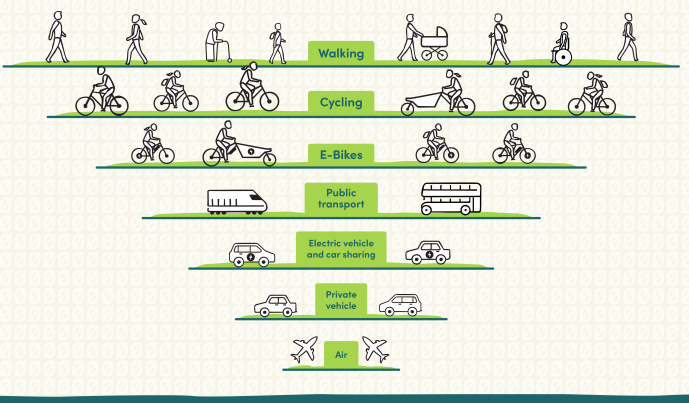
Going Green on the Go: Sustainable Transportation Options
Transportation is a critical aspect of modern society, providing mobility to people and goods. However, transportation is also one of the biggest contributors to greenhouse gas emissions and air pollution, leading to negative impacts on the environment and public health. As such, there is an urgent need for sustainable transportation options that can reduce carbon footprints and support a cleaner and healthier world. This article explores various eco-friendly transportation choices that individuals and businesses can adopt to go green on the go.
Benefits of Sustainable Transportation
Sustainable transportation options offer several benefits, such as reducing greenhouse gas emissions, improving air quality, saving money, promoting physical activity, and reducing traffic congestion. By choosing eco-friendly modes of transportation, individuals and businesses can help mitigate climate change and support sustainable development.
Public Transportation
Public transportation refers to the transportation systems that are available to the general public, such as buses, trains, subways, and ferries. Public transportation is a cost-effective and eco-friendly option that can help reduce traffic congestion and improve air quality.
Advantages of Public Transportation
Using public transportation can offer several advantages, such as:
- Lower carbon footprint: Public transportation emits fewer greenhouse gas emissions per person than private vehicles, making it a more sustainable choice.
- Cost-effective: Public transportation is often cheaper than driving a car, especially when considering fuel, maintenance, and parking costs.
- Reduced traffic congestion: Public transportation can help reduce traffic congestion, making roads less congested and safer for everyone.
- Reduced parking demand: Using public transportation reduces the demand for parking, which can be a scarce resource in urban areas.
- Improved air quality: Public transportation emits fewer pollutants per person than private vehicles, leading to improved air quality and public health.
Types of Public Transportation
There are several types of public transportation options, such as:
- Buses: Buses are the most common form of public transportation and are available in most cities and towns. They are cost-effective and offer flexible routes and schedules.
- Trains: Trains are a more rapid and comfortable mode of public transportation that can cover longer distances. They are often used for intercity or commuter transportation.
- Subways: Subways are underground trains that are used in large cities for rapid transit. They are often faster than buses and trains and can carry a large number of passengers.
- Ferries: Ferries are boats that are used for transportation across water bodies, such as rivers or bays. They are often used for intercity or tourist transportation.
Using Public Transportation Efficiently
To use public transportation efficiently, consider the following tips:
- Plan your trip ahead of time and check the schedules and routes of public transportation options.
- Purchase a pass or ticket in advance to save time and money.
- Arrive at the station or stop early to avoid missing the bus or train.
- Use real-time information services to check for delays or cancellations.
- Use apps or websites to track your trip and find connections.
- Respect the rules and etiquette of public transportation, such as not blocking the apron or seat next to you, giving up your seat to someone who needs it more, and not littering.
Cycling
Cycling is a healthy and eco-friendly way of transportation that can offer several benefits, such as reducing air pollution, promoting physical activity, and saving money on gas and car maintenance.
Benefits of Cycling
Some of the key benefits of cycling include:
- Reduced carbon footprint: Cycling emits zero greenhouse gas emissions, making it one of the most sustainable modes of transportation available.
- Physical activity: Cycling can help promote physical activity, leading to better health and reduced healthcare costs.
- Cost-effective: Cycling is a cheap mode of transportation, requiring only the cost of the bike and occasional maintenance.
- Reduced traffic congestion: Cycling reduces the number of cars on the road, leading to less traffic congestion and safer roads.
- Improved mental health: Cycling can improve mental health by reducing stress levels and promoting a sense of well-being.
Types of Cycling
There are several types of cycling that individuals can choose from, such as:
- Commuting: Commuting by bike involves riding a bike to work or school. It is a cost-effective and sustainable way to get around, especially for short distances.
- Recreational: Recreational cycling involves riding a bike for fun or exercise. It can be done alone or in groups, and can take place on roads, trails, or other designated bike paths.
- Bike Sharing: Bike sharing involves renting a bike from a shared system and using it for short trips. It is a flexible and affordable option for those who do not own a bike.
Cycling Safety
To cycle safely, consider the following tips:
- Wear a helmet and other protective gear.
- Follow traffic laws and signals.
- Use hand signals to communicate your intentions to other road users.
- Ride in designated bike lanes or on the right side of the road.
- Be aware of your surroundings and stay visible to other road users.
- Maintain your bike in good condition and regularly check the brakes and tires.
Walking
Walking is a sustainable and healthy mode of transportation that can be used for short distances. It is a low-impact activity that can offer several benefits, such as improved physical health, reduced air pollution, and increased community engagement.
Benefits of Walking
Some of the key benefits of walking include:
- Reduced carbon footprint: Walking emits zero greenhouse gas emissions, making it one of the most sustainable modes of transportation available.
- Physical activity: Walking can help promote physical activity, leading to better health and reduced healthcare costs.
- Cost-effective: Walking is a free mode of transportation that requires no equipment or maintenance.
- Improved mental health: Walking can improve mental health by reducing stress levels and promoting a sense of well-being.
Walking Tips
To walk safely and efficiently, consider the following tips:
- Use designated sidewalks or walking paths.
- Wear comfortable shoes and dress for the weather.
- Be aware of your surroundings and stay visible to other road users.
- Use crosswalks and follow traffic signals.
- Walk with a friend or in a group for added safety and socialization.
Electric Vehicles
Electric vehicles (EVs) are a sustainable mode of transportation that are powered by electricity rather than gasoline. They offer several benefits, such as reducing greenhouse gas emissions, promoting energy independence, and saving money on fuel costs.
Advantages of Electric Vehicles
Some of the key advantages of EVs include:
- Reduced carbon footprint: EVs emit fewer greenhouse gas emissions per mile than gasoline vehicles, making them a more sustainable choice.
- Lower fuel costs: EVs can save money on fuel costs, especially if charged at home or at a low-cost charging station.
- Energy independence: EVs can reduce dependence on foreign oil and promote energy independence.
- Reduced air pollution: EVs emit no tailpipe pollutants, leading to improved air quality and public health.
- Quiet and smooth operation: EVs are quieter and smoother than gasoline vehicles, leading to a more comfortable driving experience.
Types of Electric Vehicles
There are several types of EVs available, such as:
- Battery electric vehicles (BEVs): BEVs are fully electric vehicles that rely solely on battery power. They are the most sustainable type of EVs and offer the longest range.
- Plug-in hybrid electric vehicles (PHEVs): PHEVs use both electricity and gasoline to power the vehicle. They offer a longer range than BEVs but have a higher carbon footprint.
- Hybrid electric vehicles (HEVs): HEVs use electricity and gasoline to power the vehicle, but the electricity is generated through regenerative braking. They offer better fuel efficiency than traditional gasoline vehicles but have a higher carbon footprint than EVs.
Charging Infrastructure
To charge an EV, individuals need access to charging infrastructure, such as:
- Home charging stations: Home charging stations are the most convenient and cost-effective way to charge an EV. They can be installed in a garage or outdoors and can fully charge an EV overnight.
- Public charging stations: Public charging stations are available in various locations, such as parking lots, malls, and rest areas. They can provide quick charging for EVs on the go.
- Workplace charging stations: Workplace charging stations can be installed in company parking lots to provide employees with a convenient and sustainable way to commute to work.
Carpooling and Ride-Sharing
Carpooling and ride-sharing involve sharing a ride with other people who are traveling to the same destination. It is a sustainable and cost-effective way to reduce carbon footprints, save money on transportation costs, and reduce traffic congestion.
Benefits of Carpooling and Ride-Sharing
Some of the key benefits of carpooling and ride-sharing include:
- Reduced carbon footprint: Carpooling and ride-sharing reduce the number of vehicles on the road, leading to lower carbon emissions and a more sustainable mode of transportation.
- Cost-effective: Carpooling and ride-sharing can help individuals save money on transportation costs, such as gas, tolls, and parking fees.
- Reduced traffic congestion: Carpooling and ride-sharing reduce the number of cars on the road, leading to less traffic congestion and faster travel times.
- Socialization: Carpooling and ride-sharing can provide an opportunity for individuals to socialize with others who are traveling to the same destination.
Types of Carpooling and Ride-Sharing
There are several types of carpooling and ride-sharing options available, such as:
- Traditional carpooling: Traditional carpooling involves sharing a ride with coworkers, neighbors, or friends who are traveling to the same destination. It can be arranged through personal connections or online platforms.
- Ride-sharing services: Ride-sharing services, such as Uber and Lyft, involve sharing a ride with a stranger who is traveling to the same destination. It is a flexible and convenient option for those who do not have a car or prefer not to drive.
- Vanpooling: Vanpooling involves sharing a ride in a van with several people who are traveling to the same destination. It is a cost-effective option for longer commutes.
Conclusion
Sustainable transportation options are crucial for reducing carbon footprints and promoting a cleaner and healthier world. Public transportation, cycling, walking, electric vehicles, and carpooling/ride-sharing are all viable options that individuals and businesses can adopt to go green on the go. By choosing eco-friendly modes of transportation, we can all play a part in mitigating climate change and supporting sustainable development.
FAQs
- How can I find public transportation options in my area?
- You can search for public transportation options in your area through online platforms, such as Google Maps or local transportation authority websites.
- Are electric vehicles more expensive than gasoline vehicles?
- Initially, electric vehicles can be more expensive than gasoline vehicles, but they can save money in the long run through fuel and maintenance costs.
- How can I stay safe while cycling?
- Wear a helmet and other protective gear, follow traffic laws and signals, and stay visible to other road users.
- Is walking a feasible mode of transportation for longer distances?
- Walking is a feasible mode of transportation for short distances, but may not be suitable for longer distances.
- How can I find carpooling or ride-sharing options in my area?
- You can search for carpooling or ride-sharing options in your area through online platforms, such as Uber, Lyft, or local carpooling websites.
